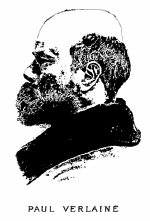Paul Verlaine
Template:French literature (small)
Paul Marie Verlaine (French IPA pronunciation: [vɛʀˈlɛn]) (March 30, 1844 – January 8, 1896) is considered one of the greatest and most popular of French poets.
Born in Metz, he was educated at a lycée in Paris and then took up a post in the civil service. He began writing poetry at an early age, and was initially influenced by the Parnassien movement and its leader, Charles Leconte de Lisle.
Verlaine's first published collection, Poèmes saturniens (1867), though criticised by Sainte-Beuve, established him as a poet of promise and originality. Verlaine's private life spills over into his work, beginning with his love for Mathilde Mauté, who became his wife. Mathilde Mauté is referred to as a disciple of Louise Michel. At the proclamation of the French Third Republic in 1870, Verlaine joined the 160th battalion of the Garde nationale, turning Communard on March 18, 1871. He became head of the press bureau of the Central Committee of the Paris Commune. He escaped the deadly street fighting known as the Bloody Week, or the "Semaine Sanglante" and went into hiding in Pas-de Calais. He returned to Paris in August 1871. In September 1871 he received the first letter of Arthur Rimbaud. By 1872 he had lost interest in Mathilde, and effectively abandoned her and their son, preferring the company of his lover, the poet Arthur Rimbaud. Verlaine was a heavy drinker, and shot Rimbaud in a jealous rage, fortunately not killing him. As an indirect result of the incident, he was arrested and imprisoned at Mons, where he underwent a conversion to Catholicism, which again influenced his work. Romances sans paroles was the poetic outcome of this period.
Following his release, Verlaine travelled to England, where he worked for some years as a teacher and worked on another successful collection, Sagesse. He returned to France in 1877, and, while teaching English at a school in Rethel, became infatuated with one of his pupils, Lucien Létinois, who inspired further poems. Verlaine was devastated when the boy died of typhus.
Verlaine's last years witnessed a descent into alcoholism, and poverty. Yet even in his lifetime, his poetry was recognised as ground-breaking. Perhaps the best-known of Verlaine's poems is Chanson d'automne, largely thanks to its use as a code message for the Allies during the Second World War. Verlaine's poetry was also popular with musicians, such as Gabriel Fauré, who set several of his poems to music, including La bonne chanson, and Claude Debussy, who set his entire Fêtes galantes collection.
Numerous portraits of Verlaine were left by French artists. Among the most illustrious: Henri Fantin-Latour, Antonio de La Gandara, Eugène Carrière, Frédéric Cazals, and Théophile-Alexandre Steinlen.
On his death in 1896, Paul Verlaine was interred in the Cimetière des Batignolles in Paris.
Works
- Poèmes saturniens (1866)
- Les Amies (1867)
- Fêtes galantes (1869)
- La Bonne chanson (1870)
- Romances sans paroles (1874)
- Sagesse (1880)
- Les Poètes maudits (1884)
- Jadis et naguère (1884)
- Amour (1888)
- Parallèlement (1889)
- Dédicaces (1890)
- Femmes (1890)
- Hombres (1891)
- Bonheur (1891)
- Mes hôpitaux (1891)
- Chansons pour elle (1891)
- Liturgies intimes (1892)
- Mes prisons (1893)
- Élégies (1893)
- Odes en son honneur (1893)
- Dans les limbes (1894)
- Épigrammes (1894)
- Confessions (1895)
ReferencesISBN links support NWE through referral fees
- Paul Verlaine, Correspondance générale : [Vol.] I, 1857-1885 (edited and annotated by Michael Packenham). Paris : Fayard, 2005. 16 x 24 cm. 1,122 pages. ISBN 2-213-61950-6
Credits
New World Encyclopedia writers and editors rewrote and completed the Wikipedia article in accordance with New World Encyclopedia standards. This article abides by terms of the Creative Commons CC-by-sa 3.0 License (CC-by-sa), which may be used and disseminated with proper attribution. Credit is due under the terms of this license that can reference both the New World Encyclopedia contributors and the selfless volunteer contributors of the Wikimedia Foundation. To cite this article click here for a list of acceptable citing formats.The history of earlier contributions by wikipedians is accessible to researchers here:
The history of this article since it was imported to New World Encyclopedia:
Note: Some restrictions may apply to use of individual images which are separately licensed.
